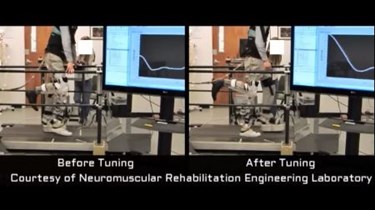An Algorithm To Automatically "Tune" Powered Prosthetics

As amputees work with and adjust to powered prosthetics, they often require the assistance of a prosthetist, who can tune their devices to suit changes in their bodies. A new algorithm, developed by scientists in North Carolina, may cut down on the number of tune-ups by allowing the device to adjust to changes automatically. Researchers say that the innovation could make powered prosthetics more versatile in real-time as well as save their users a lot of time and money.
According to scientists at Michigan Technological University, above-the-knee amputees are twice as likely to injure themselves by falling as the elderly population, due in part to limitations in prosthetics. Recent research is working toward developing devices that more closely mimic natural gait and intuitive movements by incorporating smart technology and personalized tailoring.
Traditionally, a human expert works with powered prosthetics and the user to tune the device to suit the individual’s size and level of strength. A prosthetist adjusts the amount of power the prosthetic expends so that the device maintains a knee joint angle consistent with able-bodied motion. Any changes to the patient’s body or ability — such as a change in weight or loss of strength — would require a trip back to the prosthetist, which can become tedious and expensive.
A team of researchers from North Carolina State University (NCS) and the University of North Carolina—Chapel Hill (UNCCH) wondered if might be possible automate the tuning process. Their project resulted in an algorithm that can be incorporated into the software of any powered prosthetic, and they found that it not only adjusted to more permanent bodily changes, but also to circumstantial ones. For example, users could receive an extra boost when hauling a suitcase through an airport.
Helen Huang, an associate professor of biomedical engineering at both universities who led the research, said in a press release that, for certain functions, the algorithm performed better than human experts.
“In testing, we found that the computer — using the algorithm — performed better than prosthetists at achieving the proper joint angle. So we know our approach works,” said Huang. “But we’re still working to make it better.”
Huang said that human experts are still better able to adjust the device for a comfortable walking posture. “We’re still not yet able to replicate the prosthetist’s success in achieving those comfortable ‘trunk motions,’” she said, “but it’s something we’re working on.”
In a study published in Annals of Biomedical Engineering, researchers commented that their research was still a work in progress but, if successful, the algorithm would go a long way towards making powered prosthetics more practical for clinical use.
